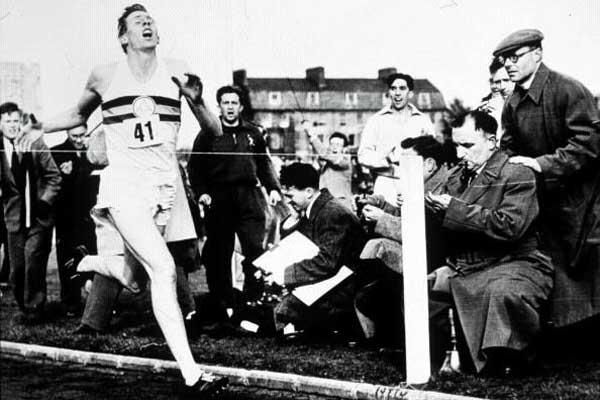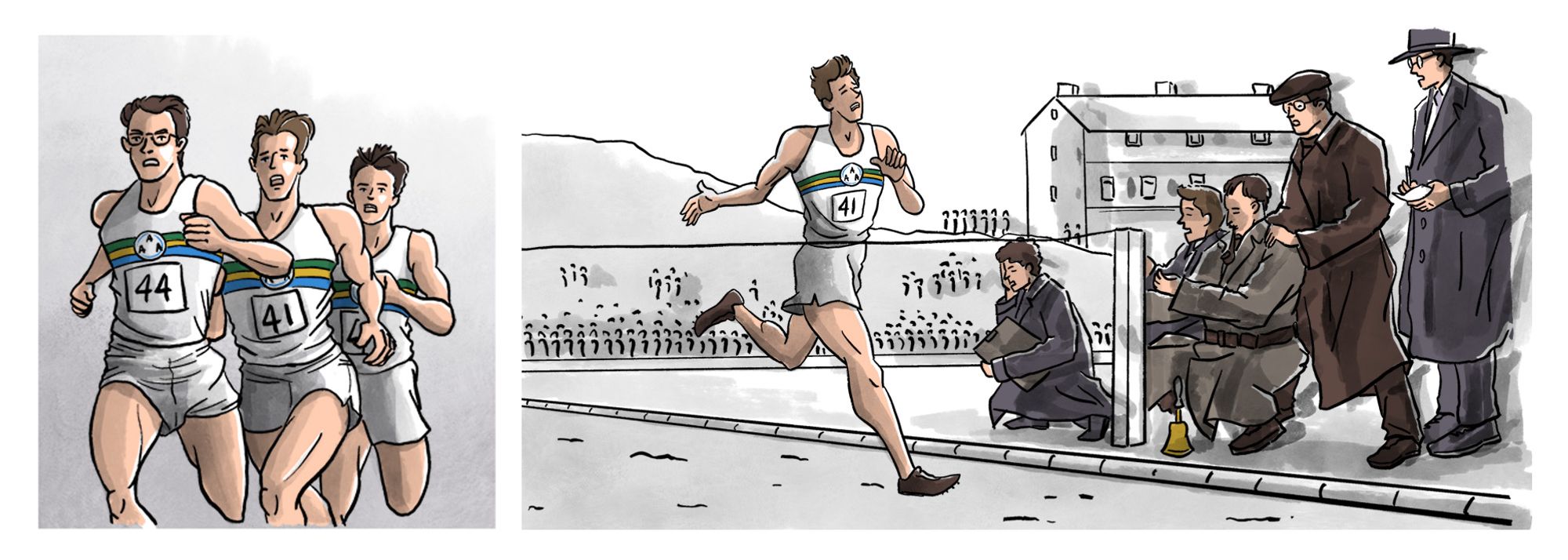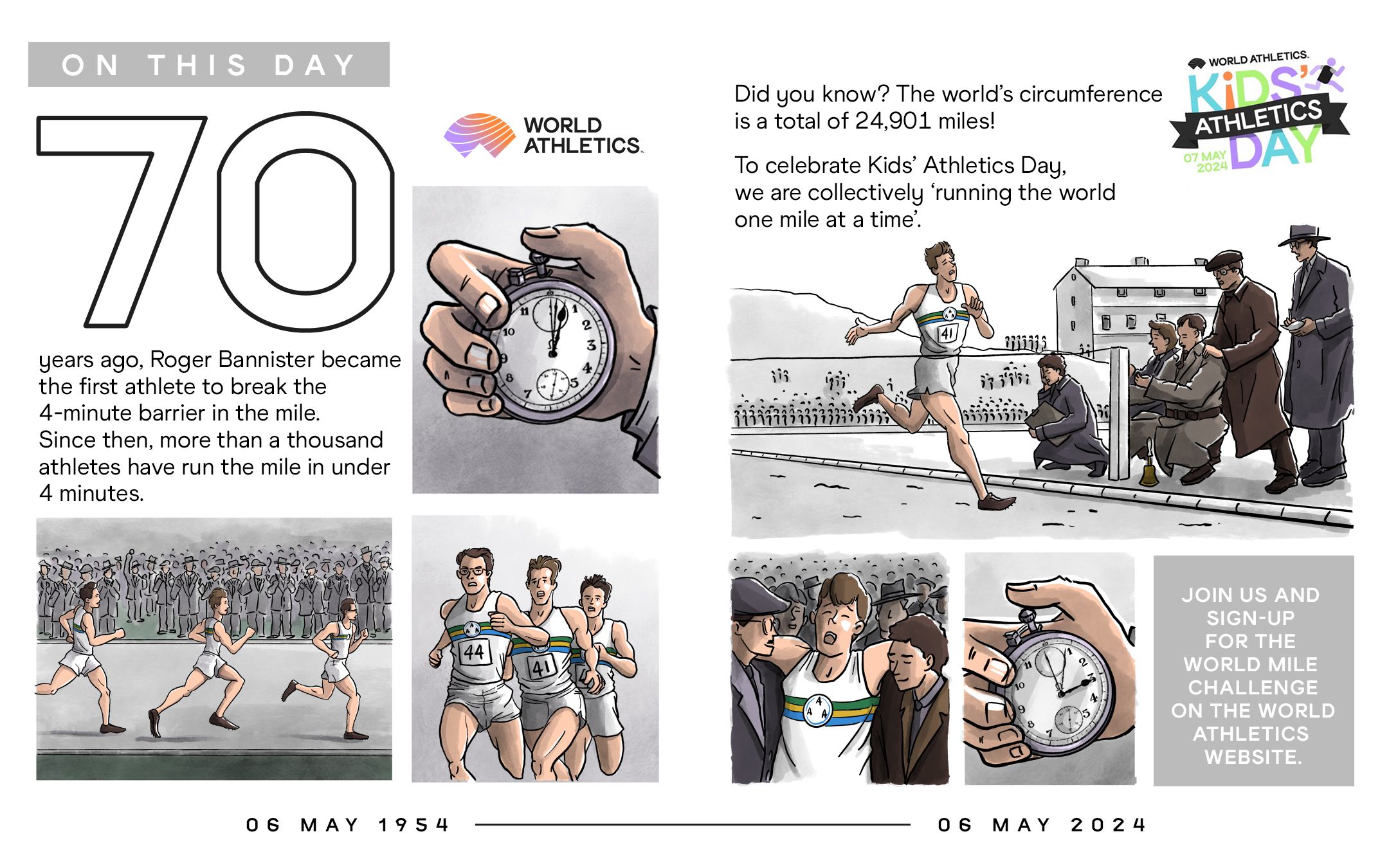Roger Bannister breaks four minutes for the mile (© Christel Saneh)
The 70th anniversary of Sir Roger Bannister’s sub-four-minute mile has been celebrated in Oxford across the bank holiday weekend of 4-6 May.
A three-day pop-up Museum of World Athletics (MOWA) 1500m & Mile Heritage Display at Oxford University Athletics Club’s (OUAC) track at Iffley Road culminates today (6) with the OUAC’s Bannister Miles, a day of road and track mile races.
Two World Athletics Heritage Plaques, one honouring Bannister and the other the OUAC, which was founded in 1860, are being unveiled at Iffley Road. Celebrations conclude with a formal dinner at Exeter College in the evening.
First four minutes
In pursuit of the ultimate race against the unforgiving hand of the clock, time seemed to stand still for Roger Bannister as he attacked the Everest of athletic achievements, the sub-four-minute mile, late on the afternoon of 6 May 1954.
It was on the final lap of the mile race in the Oxford University v Amateur Athletic Association match at the Iffley Road track in Oxford when the 25-year-old medical student overtook the second of his pacemakers, Chris Chataway, and prepared to enter unchartered territory.
“I had a moment of mixed joy and anguish, when my mind took over,” the future Sir Roger wrote in his book First Four Minutes, reflecting on his push towards the historic 3:59.4 clocking.
“My mind seemed almost detached from my body. It raced well ahead of my body and drew my body compellingly forward. I felt like the moment of a lifetime had come.
“The world seemed to stand still, or did not exist. The only reality was the next 200 yards of track under my feet. The tape meant finality, extinction perhaps.
“I felt at that moment that it was my chance to do one thing supremely well. I drove on, impelled by a combination of fear and pride. The air I breathed filled me with the spirit of the track where I had run my first race.”

Roger Bannister breaks the four minute mile barrier (© Getty Images)
You haven’t got the strength
It had been at Iffley Road in 1946 that the callow 17-year-old Roger Gilbert Bannister, a first-year medical student at Exeter College, Oxford, first set foot on a running track.
After several laps of what was then a 330-yard circuit, on which it had become conventional to run in a clockwise direction, the rookie was approached by the groundsman, who told him how Jack Lovelock used to train there in his time as an Oxford medical student. The New Zealander set a world mile record of 4:07.6 in Brooklyn in 1933 and won the 1936 Olympic 1500m title in a world record 3:47.8.
“But I’m afraid you’ll never be any good,” the groundsman told the crestfallen young Bannister. “You just haven’t got the strength or the build for it.”
Two weeks later, resplendent in his school team rowing kit, he ran his first track race, also at Iffley Road. He finished second in the mile at the Freshman’s Sports, clocking a modest 4:53.
Helsinki disappointment – inspired by Landy
Much had happened in the eight years between then and the fateful mile at Iffley Road in May of 1954.
As President of the Oxford University Athletics Club, Bannister pushed through the rebuilding of the track to standard 440-yard specification (and with a change of running direction to the conventional anti-clockwise).
He had also undergone the excruciating experience of being publicly dubbed “a failure” for finishing fourth in the 1952 Olympic 1500m final in Helsinki. Having chosen to keep his form under wraps in training while racing only in under-distance events that summer, he had been undermined by the last-minute introduction of semifinals, requiring three 1500m races on consecutive days.
The day before that shattering schedule announcement, Bannister ran a three-quarter mile time trial in 2:59.9, which he rated as “equal to, if not better, than a four-minute mile.”
By 1954, he had started to train in company for the first time – on his weekday lunchbreaks from St Mary’s Hospital in London – and at weekends with his good friends and fellow Olympians Chris Brasher and Chris Chataway, under the direction of Brasher’s Austrian coach Franz Stampfl.
Inspired by news of John Landy closing in on the four-minute barrier with a succession of sub-4:03 runs in Australia, Bannister began to embrace interval training, starting off by running a series of 10 reps of 400m, with a recovery of two minutes, in an average of 66 seconds - until he got down to 58 seconds.
“Relax!”
By May 1954, it was clear he was ready for a serious assault in the annual Oxford University v AAA match but when the day arrived he was racked by doubts, mainly due to the strength of a gale force wind he encountered when he finished his morning shift at St Mary’s and made the train trip up to Oxford.
Only when he saw the flag on top of a nearby church stop fluttering wildly did his thoughts of postponement give way to the task of chasing a place in posterity with the pacemaking help of his two new training partners.
“Brasher went into the lead and I slipped in effortlessly behind him, feeling tremendously full of running,” Bannister recounted in First Four Minutes. “I shouted ‘Faster!’ but Brasher kept his head and did not change his pace. I went on worrying until I heard the first lap time, 57.5.
“At one and a half laps I was still worrying about the pace. A voice shouting ‘Relax!’ penetrated me above the noise of the crowd. I learned afterwards it was Stampfl’s. Unconsciously I obeyed.
“I barely noticed the half mile, passed in 1:58, nor when, round the next bend, Chataway went into the lead. At three quarters of a mile the effort was still barely perceptible; the time was 3:00.7, and by now the crowd were roaring.
“Chataway led round the next bend and then I pounced past him at the beginning of the back straight, 300 yards from the finish.”
Then came that moment when Bannister reached his higher plane - travelling through a suspension in time towards his home-straight destiny.
“Those last few seconds seemed never ending,” he wrote. “The faint line of the finishing tape stood ahead as a haven of peace, after the struggle. I leapt at the tape like a man taking his last spring to save himself from the chasm that threatens to engulf him.
“My effort was over and I collapsed almost unconscious. I felt like an exploded flashlight. I knew that I had done it before I even heard the time.”
The official announcement was made by another close friend of Bannister, Norris McWhirter. “Result of event eight: one mile,” began the statistician who was to go on to found The Guinness Book of Records with his twin brother, Ross. “First, RG Bannister of Exeter and Merton Colleges, in a time which, subject to ratification, is a new track record, British native record, British all-comers’ record, European record and world record. Three minutes…”
“I felt free from the burden of athletic ambition”
“The rest was lost in the roar of excitement,” Bannister continued. “I grabbed Brasher and Chataway, and together we scampered round the track in a burst of spontaneous joy. We had done it – the three of us!
“We shared a place where no man had yet ventured, secure for all time, however fast men might run miles in future. I felt suddenly and gloriously free from the burden of athletic ambition that I had been carrying for years.”
At 25, Bannister had conquered the ultimate peak of sporting endeavour, a year after the successful British conquest of Mount Everest. His time, 3:59.4, was an advancement of some nine yards on the nine-year-old world record of 4:01.4 held by the Swede Gunder Hagg.
Bannister’s figures only survived as a world record for 46 days, yet his barrier-breaking feat has endured for seven decades now as the most momentous achievement in the long, distinguished history of track and field.
Simon Turnbull for World Athletics Heritage





